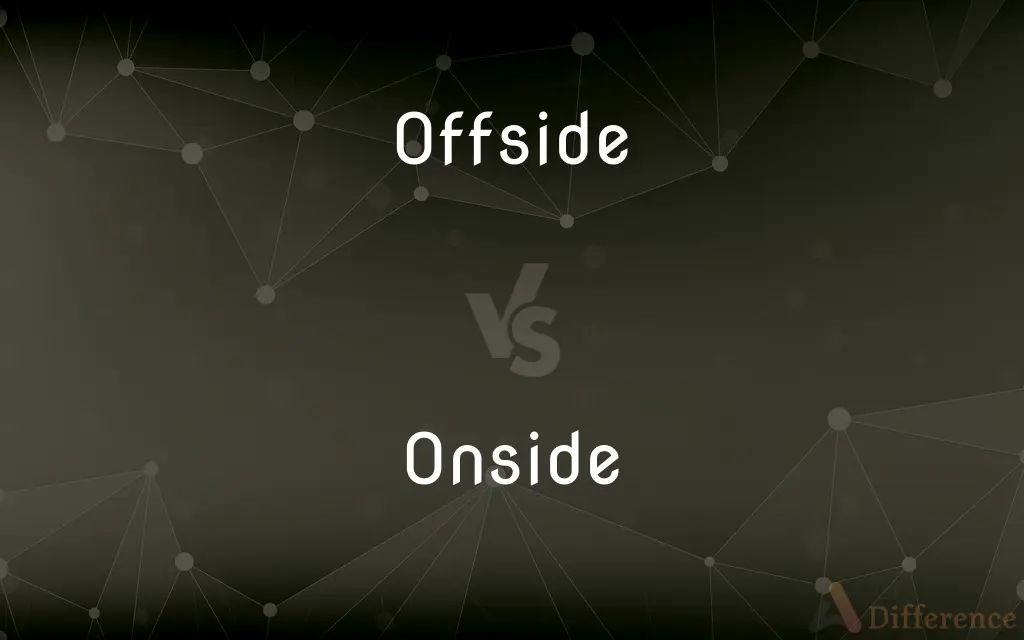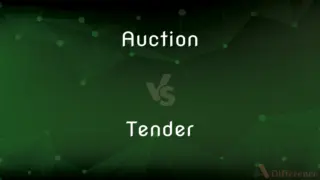Offside vs. Onside — What's the Difference?
By Tayyaba Rehman & Fiza Rafique — Updated on March 29, 2024
Offside in sports is a player being in a position closer to the opponent's goal line than the ball and the second-last opponent when the ball is played to them. Onside indicates a player is in a legal position, not breaching the offside rule.

Difference Between Offside and Onside
Table of Contents
ADVERTISEMENT
Key Differences
The offside rule is a fundamental aspect of various sports, including soccer, rugby, and hockey, designed to prevent players from gaining an unfair positional advantage. In soccer, a player is considered offside if they are nearer to the opponent's goal line than both the ball and the second-last opponent (including the goalkeeper) at the moment the ball is played to them by a teammate, and they are involved in active play. On the other hand, being onside means a player is positioned in such a way that they do not violate the offside rule at the moment the ball is played. This legal position allows the player to participate in the game without penalty.
In application, the offside rule can significantly influence the flow and strategy of a game. Teams must carefully coordinate their movements and passes to avoid offside violations, which can nullify scoring opportunities. Conversely, defenses might employ strategies such as the offside trap to catch opponents off guard and in an offside position, thereby gaining possession of the ball.
The determination of offside or onside is often made by assistant referees in soccer, who monitor players' positions in relation to the ball and opponents. This judgment can be one of the most challenging and contentious aspects of officiating, given its reliance on timing and positioning.
Despite the offside rule's complexity, its enforcement is essential for maintaining the integrity and competitive balance of sports. It ensures that players cannot simply loiter near the opponent's goal and must instead engage in active play, thus preserving the dynamic and strategic nature of team sports.
Comparison Chart
Definition
A player is in an illegal position, closer to the opponent's goal line than the ball and the second-last opponent.
A player is in a legal position, not closer to the opponent's goal line than the ball and the second-last opponent.
ADVERTISEMENT
Consequence
Leads to a penalty such as a free kick for the opposing team.
Play continues without penalty.
Purpose
To prevent players from gaining an unfair advantage by being in a forward position too early.
To ensure fair play by allowing players to participate without breaking the offside rule.
Strategic Implications
Players must be mindful of their position to avoid nullifying potential scoring opportunities.
Players can freely engage in play and contribute to the team's offensive and defensive efforts.
Determination
Made by officials based on players’ positions at the moment the ball is played.
Assessed continuously by officials to ensure fair play throughout the game.
Compare with Definitions
Offside
A player is positioned too close to the opponent's goal line when the ball is played.
He was flagged offside just as he received the pass.
Onside
Allows play to continue without penalty.
The assistant referee judged her to be onside, and the play went on.
Offside
Violation of the positional rule, leading to a free kick.
Their striker’s offside position resulted in a free kick for us.
Onside
Essential for successful team strategies.
Staying onside was key to their counter-attacking strategy.
Offside
Can nullify a goal if the player is offside.
The crowd’s cheer was cut short when the goal was disallowed for offside.
Onside
Demands good spatial awareness and timing.
His ability to stay onside despite the tight defense was remarkable.
Offside
A rule that encourages strategic play and movement.
Their team’s understanding of the offside rule was apparent in their disciplined formation.
Onside
A legal position where the player is not closer to the goal line than the ball and the second-last opponent.
He managed to stay onside and scored.
Offside
Requires timing and spatial awareness to avoid.
The forward constantly flirted with the offside line, trying to exploit the defense.
Onside
Facilitates dynamic and fair play.
Their onside play led to several legitimate scoring opportunities.
Offside
(Sports) Illegally ahead of the ball or puck in the attacking zone.
Onside
In such a position as to be able to play or receive a ball or puck in compliance with the rules.
Offside
(Football) Illegally beyond the line of scrimmage when the ball is snapped or ahead of the ball when the ball is kicked on a kickoff.
Onside
(sports) Not in an offside position; In the part of the playing area where one can legally play the ball, puck, etc.
The goal was allowed because the attacker was onside.
Offside
An offside motion or play.
Onside
On the side of a vehicle from which the driver, paddler, etc. propels it.
Offside
(sports) In an illegal position ahead of the ball, puck, etc.
Onside
(bridge) Favourably located, from the point of view of the player taking a finesse.
Offside
(US) To the side of the road, past the curb and sidewalk.
An offside diner
Onside
In agreement or support; on board.
Offside
(bridge) Unfavourably located, from the point of view of the player taking a finesse.
Onside
(sport) The portion of the playing area where one can legally play the ball, puck, etc.
Offside
To the side of a boat, opposite the primary side on which one paddles.
Onside
The side of a vehicle on which the driver primarily propels it.
Offside
(sports) An offside play.
Onside
Not offside; being within the prescribed area of play.
Offside
The side of a road vehicle furthest from the kerb: the right side if one drives on the left of the road.
My offside wing mirror got snapped off.
Onside
Not offside; being within the prescribed area of play
Offside
The right-hand side of a working animal such as a horse or bullock, especially when in harness.
Offside
The side opposite the towpath.
Offside
Illegally beyond a prescribed line or area or ahead of the ball or puck; - in sports such as football or hockey; as, the touchdown was nullified because the left tackle was offside.
Offside
Illegally beyond a prescribed line or area or ahead of the ball or puck;
The touchdown was nullified because the left tackle was offside
Offside
Illegally in advance of the ball or puck
Common Curiosities
Why is the offside rule important in sports?
The offside rule is crucial for maintaining fairness and encouraging strategic, active participation, preventing players from gaining an unfair advantage by being too far forward.
How do officials determine if a player is offside or onside?
Officials use their judgment, positioning, and sometimes technological aids like VAR in soccer, to determine if a player is offside or onside based on their position when the ball is played.
Is there an offside rule in all team sports?
Not all team sports have an offside rule; its presence and application vary depending on the sport's specific rules and dynamics.
Can the offside rule change the outcome of a game?
Yes, offside decisions can significantly impact the game's outcome, affecting goal scoring opportunities and the overall strategy of the teams.
What happens if a goal is scored from an offside position?
If a goal is scored from an offside position, it is disallowed, and the opposing team is awarded a free kick from the position where the offside occurred.
Can a player be offside in their own half?
In soccer, a player cannot be offside in their own half of the field, regardless of their position relative to the second-last opponent.
What triggers an offside penalty in soccer?
An offside penalty is triggered when a player is in an offside position at the moment the ball is played to them by a teammate and is involved in active play.
Can a player be offside if they don't touch the ball?
Yes, a player can be penalized for being offside even without touching the ball if they are involved in the play, such as obstructing the goalkeeper’s view.
How is onside different from offside in rugby?
In rugby, offside and onside positions are determined by the ball's location in relation to the players, with specific rules for different phases of play, emphasizing the sport's distinct dynamics compared to soccer.
How do players train to avoid offside penalties?
Players train to avoid offside penalties by developing spatial awareness, timing, and understanding of the game's tactical aspects to time their movements accurately.
What is the offside trap in soccer?
The offside trap is a defensive strategy where defenders move upfield simultaneously to catch opposing players offside, aiming to disrupt the attackers' timing and gain possession.
Share Your Discovery

Previous Comparison
Alb vs. Cassock
Next Comparison
Auction vs. TenderAuthor Spotlight
Written by
Tayyaba RehmanTayyaba Rehman is a distinguished writer, currently serving as a primary contributor to askdifference.com. As a researcher in semantics and etymology, Tayyaba's passion for the complexity of languages and their distinctions has found a perfect home on the platform. Tayyaba delves into the intricacies of language, distinguishing between commonly confused words and phrases, thereby providing clarity for readers worldwide.
Co-written by
Fiza RafiqueFiza Rafique is a skilled content writer at AskDifference.com, where she meticulously refines and enhances written pieces. Drawing from her vast editorial expertise, Fiza ensures clarity, accuracy, and precision in every article. Passionate about language, she continually seeks to elevate the quality of content for readers worldwide.














































